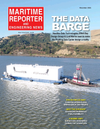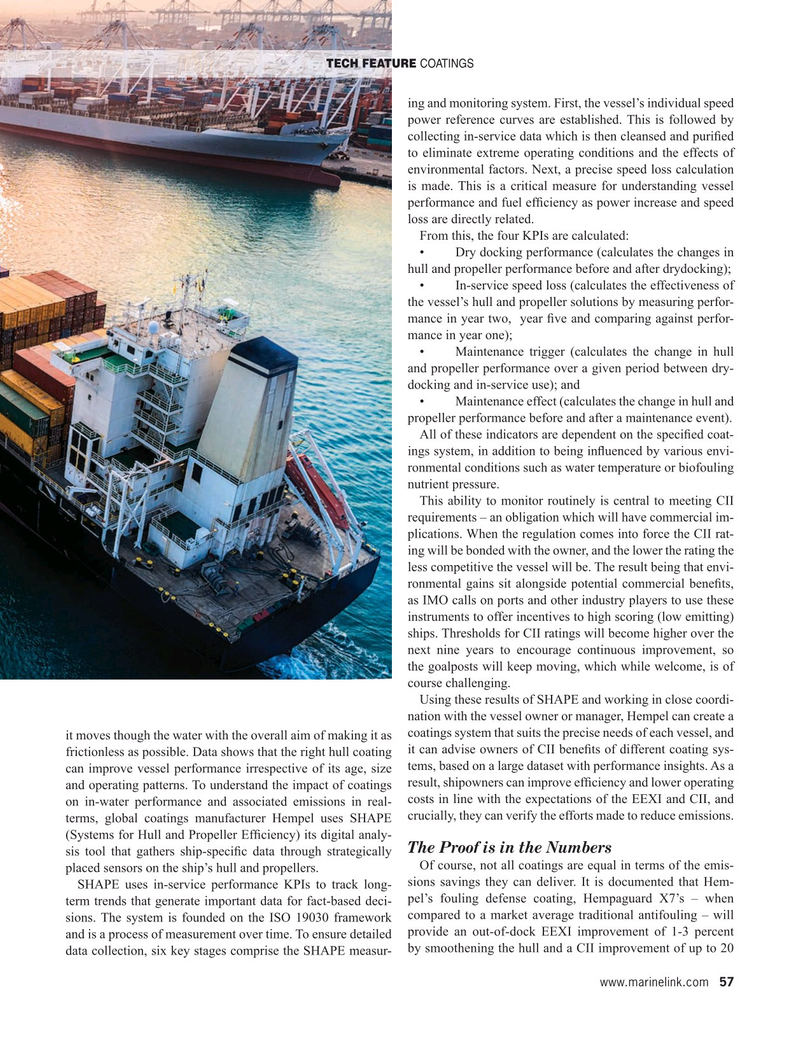
Page 57: of Maritime Reporter Magazine (November 2021)
The Workboat Edition
Read this page in Pdf, Flash or Html5 edition of November 2021 Maritime Reporter Magazine
TECH FEATURE COATINGS ing and monitoring system. First, the vessel’s individual speed power reference curves are established. This is followed by collecting in-service data which is then cleansed and puri? ed to eliminate extreme operating conditions and the effects of environmental factors. Next, a precise speed loss calculation is made. This is a critical measure for understanding vessel performance and fuel ef? ciency as power increase and speed loss are directly related.
From this, the four KPIs are calculated: • Dry docking performance (calculates the changes in hull and propeller performance before and after drydocking); • In-service speed loss (calculates the effectiveness of the vessel’s hull and propeller solutions by measuring perfor- mance in year two, year ? ve and comparing against perfor- mance in year one); • Maintenance trigger (calculates the change in hull and propeller performance over a given period between dry- docking and in-service use); and • Maintenance effect (calculates the change in hull and propeller performance before and after a maintenance event).
All of these indicators are dependent on the speci? ed coat- ings system, in addition to being in? uenced by various envi- ronmental conditions such as water temperature or biofouling nutrient pressure.
This ability to monitor routinely is central to meeting CII requirements – an obligation which will have commercial im- plications. When the regulation comes into force the CII rat- ing will be bonded with the owner, and the lower the rating the less competitive the vessel will be. The result being that envi- ronmental gains sit alongside potential commercial bene? ts, as IMO calls on ports and other industry players to use these instruments to offer incentives to high scoring (low emitting) ships. Thresholds for CII ratings will become higher over the next nine years to encourage continuous improvement, so the goalposts will keep moving, which while welcome, is of course challenging.
Using these results of SHAPE and working in close coordi- nation with the vessel owner or manager, Hempel can create a it moves though the water with the overall aim of making it as coatings system that suits the precise needs of each vessel, and frictionless as possible. Data shows that the right hull coating it can advise owners of CII bene? ts of different coating sys- can improve vessel performance irrespective of its age, size tems, based on a large dataset with performance insights. As a and operating patterns. To understand the impact of coatings result, shipowners can improve ef? ciency and lower operating costs in line with the expectations of the EEXI and CII, and on in-water performance and associated emissions in real- terms, global coatings manufacturer Hempel uses SHAPE crucially, they can verify the efforts made to reduce emissions.
(Systems for Hull and Propeller Ef? ciency) its digital analy-
The Proof is in the Numbers sis tool that gathers ship-speci? c data through strategically
Of course, not all coatings are equal in terms of the emis- placed sensors on the ship’s hull and propellers. sions savings they can deliver. It is documented that Hem-
SHAPE uses in-service performance KPIs to track long- pel’s fouling defense coating, Hempaguard X7’s – when term trends that generate important data for fact-based deci- sions. The system is founded on the ISO 19030 framework compared to a market average traditional antifouling – will and is a process of measurement over time. To ensure detailed provide an out-of-dock EEXI improvement of 1-3 percent by smoothening the hull and a CII improvement of up to 20 data collection, six key stages comprise the SHAPE measur- www.marinelink.com 57
MR #11 (50-65).indd 57 11/4/2021 11:10:21 AM

 56
56

 58
58
